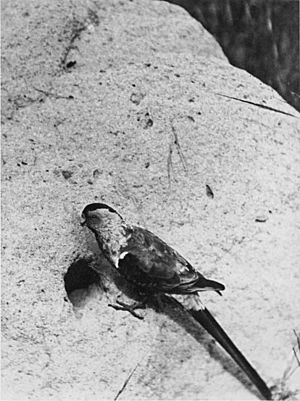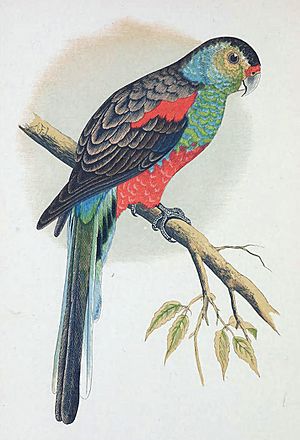Paradise parrot facts for kids
Quick facts for kids Paradise parrot |
|
|---|---|
 |
|
| Live individual photographed by the entrance to its nest, Burnett River, Queensland, 1922 | |
| Conservation status | |
| Scientific classification | |
| Genus: |
Psephotellus
|
| Species: |
pulcherrimus
|
| Synonyms | |
|
Psephotus pulcherrimus |
|
The paradise parrot (Psephotellus pulcherrimus) was a beautiful, medium-sized parrot from eastern Australia. It lived in grassy woodlands near the border of Queensland and New South Wales. This colorful bird was once quite common. Sadly, the last live paradise parrot was seen in 1927. Even after many searches, no one has found any proof that it still exists. It is the only Australian parrot known to have disappeared forever.
Contents
About the Paradise Parrot
What it Looked Like
The paradise parrot had amazing colors, even for a parrot! Its feathers were a mix of turquoise, aqua, bright red, black, and brown. Its tail was almost as long as its body. This was unusual because the bird spent most of its time on the ground, even though it could fly very fast.
Its Family Tree
The paradise parrot was first described in 1845 by a scientist named John Gould. He used notes from a field worker named John Gilbert. Gilbert had seen these parrots and collected some samples.
The paradise parrot belongs to a group of parrots called Psephotellus. Scientists have studied the genes of museum specimens. They found that the closest living relative to the paradise parrot is the golden-shouldered parrot (Psephotellus chrysopterygius). This parrot lives in northeastern Australia.
Where it Lived and How it Lived
Home and Food
Paradise parrots usually lived in pairs or small family groups. They built their nests inside hollowed-out termite mounds. These nests were often at or close to ground level.
These parrots ate mostly grass seeds. Some people who watched them said that the same pair of parrots would use the same termite mound nest year after year. They were also seen using old nests of other birds, like kingfishers or kookaburras. One pair of parrots stayed in an area of only two hectares (about 5 acres) for a whole month.
Why it Disappeared
No one is completely sure why the paradise parrot disappeared so quickly. Many things might have caused its decline. These include:
- Overgrazing: Too many farm animals eating the grass.
- Land clearing: People cutting down trees and plants for farms or homes.
- Changed fire patterns: Fires happening differently than they used to, affecting their food.
- Hunting: People collecting the birds for their beauty.
- New predators: Animals like cats and dogs that were brought to Australia and hunted the parrots.
The parrot became rare by the late 1800s. By 1915, many thought it might be extinct. A big drought in 1902 might have also played a part. Also, new farming methods where farmers burned grass to help their animals meant the parrots lost their seasonal food.
Scientists have compared the genes of the paradise parrot to other endangered birds. They found that the paradise parrot actually had more genetic diversity than some birds that are still alive but endangered. Research also shows that the parrot's population size changed a lot with temperature shifts since the last ice age.
The Last Sightings
After 1915, a few more paradise parrots were seen over the next ten years. However, the very last confirmed sighting was on September 14, 1927.
Surveys done in the late 1970s and early 1980s did not find any paradise parrots in the wild. Historical records show that the bird rapidly declined after the 1880s. In 1918, after not many sightings, people asked the public for help. This led to reports of the parrot in several places. Confirmed sightings happened in 1926 and 1927 in different areas, like Casino, New South Wales, near Ipswich, and by the Burnett River.
Gallery
-
Specimen at the Australian Museum
See also
 In Spanish: Perico del paraíso para niños
In Spanish: Perico del paraíso para niños








